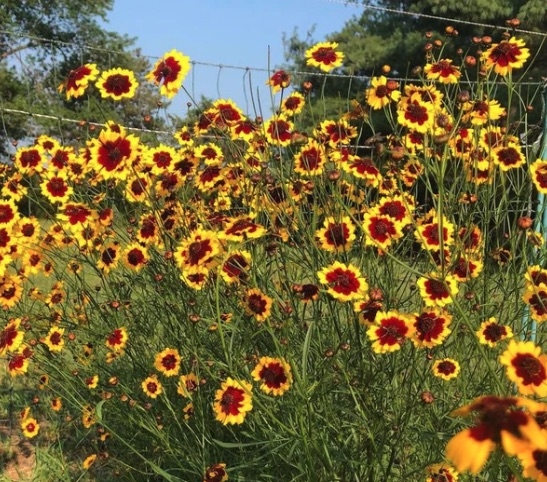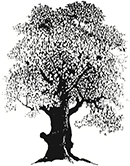MAINE-LY GARDENING: What’s in the garden? Dye plants

 by Jude Hsiang
by Jude Hsiang
Humans began farming about 12,000 years ago in locations around the world after much earlier recognized plant materials that could be used for food, clothing, shelter, and wooden tools. One thing that sets humans apart from other creatures is our desire to beautify ourselves and our surroundings. Cave paintings using the minerals ochres are 40,000 years old. Archeologists find beads and other small items carved from stone, bones, and shells.
We know that people learned to make twine, baskets and felted and woven fabrics more than 20,000 years ago. These materials rarely survived but sometimes left impressions in clay. We don’t know when they learned to color things with dyes as well as paints, but fossilized pollen from dye plants, as well as foods, can be found in caves and early settlements.
Natural fibers from plants like cotton and linen, like the animal fibers wool and mohair can be dyed with natural dyes. These fibers can be in the form of fleeces, yarn, fabric, and basketry material. Synthetic fibers like polyester will not accept natural dyes. Natural dyes can be made from minerals, fungi, lichens, and mollusks, but dyes from plants are the most common and easiest to use. Dye plants are often listed under the heading “economic botany” for their importance along with plants for food, medicine, and other useful traits.
I include dye plants in my Kennebec County garden, having begun exploring natural dyeing almost 50 years ago. I also forage dye materials locally and buy some natural dyes that only grow in tropical or subtropical regions. The entire process typically requires a mordant – a chemical salt such as alum which is also used for making pickles – and heat but is not very complex. Using proven procedures with care will produce lightfast results. Dyeing was a normal household task for centuries, even as some dyers became experts in the craft, like millers, tailors, and blacksmiths. However, as with other topics, the spread of misinformation through the internet often results in wasting fiber, dye, mordants, water, and heat. A favorite book among newer and long-time dyers is Wild Color, by Jenny Dean, published about 25 years ago.
The plant parts that provide dyes include roots, bark, wood, stems, seeds, leaves, and flowers. In some cases, several parts of the same plant can be used, perhaps for different shades; for others, only one part gives color. Sources for yellow dyes are the most common. I grow several plants for yellow: weld, dyer’s chamomile, dyer’s coreopsis, yellow cosmos, and marigolds. Any goldenrod will produce a bright yellow. Other flowers, whether red, blue, or white, still produce yellow dyes of varying quality. Onion skins can be saved for dyeing, too, and don’t require a mordant.
Although beets can be used to dye Easter eggs, they will not dye fibers as their red is not lightfast. I grow madder, the best red among plant dyes. Madder is a small, tender woody shrub from Europe and Asia that requires patience as the dye is contained in the roots which are harvested after three or four years from planting seeds. The roots of native Clayton’s bedstraw, found in swamps, also make a red dye but require a much larger quantity, and are hardly worth searching for. The very best red dyes are from several species of sub-tropical insects.
For blue I raise Japanese indigo which is more tolerant of our cool climate than other plants containing indigo. This species doesn’t have the strength of tropical indigo, but it’s fun to grow a little. Woad contains one of the indigo chemicals but at a much lower concentration. It can be invasive in croplands, but it is not on Maine’s list of invasive species. This is a reminder that conscientious dyers, like other gardeners, don’t give seeds to folks in other regions without knowing if they are potentially harmful.
As we learned as children, red, yellow, and blue can be mixed to make a wide range of colors. Adding brown and black to the whites of many natural fibers and we can have a world of color at hand. Some of the plants mentioned above are grown as annuals in our planting zone. Many plants that offer an excellent source of dye aren’t particularly interesting to look at. However, a few of them might fill a spot in a flower bed among the more glamorous blooms.
© Judith Chute Hsiang
Jude Hsiang Is a retired Extension Master Gardener instructor and member of the China Community Garden.
Responsible journalism is hard work!
It is also expensive!
If you enjoy reading The Town Line and the good news we bring you each week, would you consider a donation to help us continue the work we’re doing?
The Town Line is a 501(c)(3) nonprofit private foundation, and all donations are tax deductible under the Internal Revenue Service code.
To help, please visit our online donation page or mail a check payable to The Town Line, PO Box 89, South China, ME 04358. Your contribution is appreciated!


Leave a Reply
Want to join the discussion?Feel free to contribute!